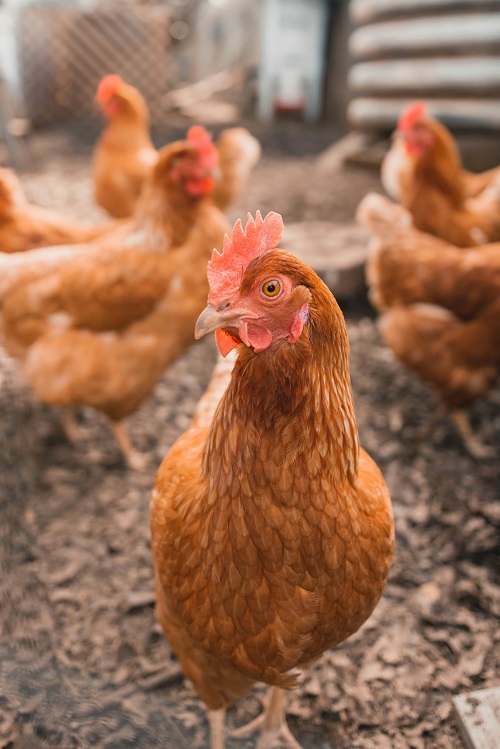Poultry Farming

Type: Agricultural Production.
Key Products for Sale:
- Fresh Eggs: Offering high-quality, organic eggs produced by free-range chickens.
- Organic Chicken Meat: Providing ethically raised, antibiotic-free chicken meat to local markets.
- Poultry Manure: Selling nutrient-rich poultry manure as organic fertilizer for gardens and farms.
Technology Considerations:
- Automated Feeding Systems: Installing automatic feeders to ensure chickens have access to balanced nutrition.
- Climate-Controlled Housing: Implementing climate-controlled housing to regulate temperature and humidity for optimal bird comfort and health.
- Egg Incubators: Using egg incubators to hatch and raise chicks in a controlled environment.
- Monitoring Sensors: Installing sensors to monitor environmental conditions and bird health in real-time.
Market for the Products:
- Local Consumers: Selling fresh eggs and chicken meat directly to consumers through farmer’s markets, roadside stands, and community-supported agriculture (CSA) programs.
- Restaurants and Cafes: Supplying local restaurants and cafes with high-quality poultry products for use in their menus.
- Retailers: Partnering with local grocery stores and specialty food shops to stock organic poultry products on their shelves.
- Gardeners and Farmers: Providing organic poultry manure as a natural fertilizer for gardens, orchards, and crop fields.
Key Inputs into the Business:
- Poultry Housing and Equipment: Building chicken coops, nesting boxes, and fencing to house and protect the birds.
- Chicks or Hatching Eggs: Purchasing day-old chicks or hatching eggs from reputable suppliers to start the flock.
- Feed and Water: Sourcing high-quality poultry feed and clean water for the birds’ nutritional needs.
- Veterinary Care: Establishing a relationship with a poultry veterinarian for regular check-ups and healthcare services.
- Labor: Hiring skilled workers to assist with daily chores such as feeding, cleaning, and egg collection.
Product Preparation Process:
- Establishing the Flock: Procuring day-old chicks or hatching eggs and raising them to maturity in a climate-controlled environment.
- Egg Production: Providing the hens with optimal nutrition, housing, and care to ensure consistent egg production.
- Meat Production (if applicable): Raising broiler chickens to market weight using ethical and sustainable farming practices.
- Egg Collection and Grading: Collecting eggs daily, cleaning them, and grading them according to size and quality standards.
- Packaging and Distribution: Packaging eggs and chicken meat in clean, sanitary containers for sale to consumers and retailers.
Quality Considerations:
- Animal Welfare: Ensuring chickens have access to clean water, nutritious feed, and ample space to exhibit natural behaviors.
- Food Safety: Implementing strict hygiene practices and regular sanitation protocols to prevent contamination and foodborne illnesses.
- Product Quality: Providing fresh, high-quality eggs and chicken meat that meet or exceed industry standards for taste, texture, and appearance.
- Environmental Sustainability: Adopting sustainable farming practices to minimize environmental impact and conserve natural resources.
Cost of Investment:
- Poultry Housing and Equipment: between KES 200,000 and KES 500,000
- Chicks or Hatching Eggs: between KES 50,000 and KES 100,000
- Feed and Water: between KES 30,000 and KES 50,000 (monthly)
- Veterinary Care: between KES 20,000 and KES 50,000 (annually)
- Labor: between KES 50,000 and KES 100,000 (monthly).
Required Operational Infrastructure:
- Poultry Housing: Constructing chicken coops, nesting boxes, and fencing to accommodate the flock.
- Water Supply: Providing clean, fresh water sources for the birds’ hydration needs.
- Feed Storage: Storing poultry feed in dry, secure containers to prevent spoilage and contamination.
- Waste Management: Implementing a waste management system to collect and dispose of manure safely and efficiently.
- Transportation: Acquiring a vehicle or partnering with a transportation service for distributing products to market.
Most Suitable or Viable Location of the Business:
- Rural Areas: Areas with ample land and access to water sources for sustainable poultry farming operations.
- Proximity to Markets: Locating the farm near urban centers or retail outlets to facilitate product distribution and sales.
- Agricultural Zones: Regions with supportive agricultural infrastructure and a strong market demand for organic poultry products.
Potential Sources of Investment Capital:
- Personal Savings: Investing personal funds or savings into starting and operating the poultry farm.
- Agricultural Loans: Securing loans from banks or financial institutions specializing in agricultural financing.
- Government Grants: Exploring grants and subsidies available for sustainable agriculture and food production initiatives.
- Partnership Opportunities: Forming partnerships with investors or agricultural organizations to access funding and expertise.
Requirements for Effective Management:
- Farm Management Skills: Acquiring knowledge and skills in poultry husbandry, nutrition, and disease management.
- Business Management Skills: Developing expertise in business planning, financial management, and marketing strategies.
- Regulatory Compliance: Understanding and adhering to local regulations and licensing requirements for poultry farming operations.
- Market Research: Conducting market research to identify consumer preferences, market trends, and competitive dynamics.
- Networking: Building relationships with industry professionals, suppliers, buyers, and local community members to support business growth and success.
Role of Mobile Phones and ICT in the Business:
- Mobile Apps: Using mobile apps for farm management tasks such as inventory tracking, scheduling, and communication.
- Market Research: Accessing online resources and databases for market research, pricing analysis, and industry news.
- Communication: Facilitating communication with suppliers, buyers, and customers via mobile phones, email, and messaging apps.
- Digital Marketing: Leveraging social media platforms, websites, and digital advertising to promote products and engage with customers.
Statutory Regulations and Licenses:
- Business Registration: Obtaining the necessary licenses and permits to operate a poultry farm, including business registration and tax compliance.
- Animal Welfare Regulations: Adhering to animal welfare standards and guidelines to ensure the health and well-being of the flock.
- Food Safety Standards: Complying with food safety regulations and quality control measures to ensure the safety and integrity of poultry products.
- Environmental Regulations: Following environmental regulations related to waste management, water usage, and land stewardship to minimize environmental impact.
Pricing:
- Competitive Pricing: Setting prices for eggs and chicken meat competitively based on market demand, production costs, and product quality.
- Value-added Pricing: Offering premium pricing for organic, free-range, or specialty poultry products that provide added value to customers.
Profitability:
- Estimated Annual Profits: Depending on farm size, production volume, and market conditions, profits can range from KES 500,000 to KES 2,000,000 or more.
- Profit Margin: Aim for a profit margin of 20-30% by optimizing production efficiency, minimizing costs, and maximizing revenue.
Next Steps to Take:
- Business Planning: Develop a detailed business plan outlining your goals, target market, products, pricing strategy, marketing plan, and financial projections. This will serve as a roadmap for your poultry farming venture.
- Secure Funding: Determine the initial capital required for setting up the poultry farm, including infrastructure, equipment, livestock, and operational expenses. Explore potential funding sources such as personal savings, agricultural loans, grants, or partnerships.
- Location Selection: Identify a suitable location for your poultry farm, considering factors such as access to water, availability of utilities, proximity to markets, and zoning regulations. Ensure the chosen location meets the requirements for poultry farming and is conducive to the health and well-being of the birds.
- Infrastructure Setup: Establish the necessary infrastructure for your poultry farm, including poultry houses or barns, feed storage facilities, egg collection areas, and processing facilities if applicable. Ensure that the infrastructure is designed to provide a comfortable and safe environment for the chickens.
- Procurement of Inputs: Source high-quality inputs such as chicken feed, chicks, bedding materials, veterinary supplies, and equipment. Establish relationships with reputable suppliers to ensure a consistent supply of inputs for your poultry farming operations.
- Livestock Acquisition: Purchase healthy day-old chicks from reputable hatcheries or breeders to start your poultry flock. Ensure that the chicks are vaccinated and free from diseases to prevent potential health issues in the flock.
- Staff Recruitment and Training: Hire skilled workers to assist with daily farm operations such as feeding, watering, cleaning, egg collection, and animal care. Provide comprehensive training to your staff on poultry farming best practices, animal welfare, and biosecurity measures.
- Implement Biosecurity Measures: Implement strict biosecurity protocols to prevent the introduction and spread of diseases in your poultry flock. This includes measures such as restricted access to the farm, disinfection procedures, and regular health monitoring of the birds.

